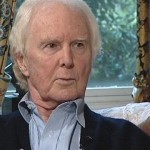Part of my daily routine during my tenure in London was, upon leaving the tube of an afternoon at Highbury Corner, fishing out 40p for the purchase of the Evening Standard from the news agent. It was in this way that I first became acquainted with the redoubtable art critic Brian Sewell. Reading art history at University College, I was initially of the opinion that Brian, as a Courtauld laureate, was heavily dosed with the snotty pills that always seemed the baggage of the competing program we at UCL usually considered as brand x. Even Brian would acknowledge that much of this was a holdover from his mentor, the controversial but none the less brilliant Courtauld director, and Soviet spy, Anthony Blunt. Indeed, as Brian has noted, it was as Blunt’s protégé at the time of Blunt’s public unmasking that catapulted Brian into prominence. Tina Brown, then editor of Tatler, sought to make hay out of Blunt’s predicament by asking Brian, who had no prior experience, to be the magazine’s art critic.
I must say that Brian did Blunt proud by standing fast against the tide, rejecting influences that might have altered his strongly held- and not always well reasoned- opinions about art and contemporary culture. Whatever these opinions were, they generally accorded with mine, so I naturally considered him tremendously insightful. What he did, in an accent both in print and orally that was incredibly posh, was, using my own vernacular, to call a spade a spade. There exists a trope in art history known as the emperor’s new clothes, and this was something that doubtless was one of Brian’s favorites. If some manner of artistic production was crap, despite fawning accolades in other quarters, he was not afraid to say so, and I must say that crap would have been one of his least objectionable adject
ives. Some of the leading lights of contemporary art were the subjects of a Brian Sewell lambasting. He was no friend of the recondite or high concept which did, in his view, mask the artist’s shortcomings. Amongst my colleagues, those to whom canonical work spoke strongest loved Brian; those who tended to cleave to animals in formaldehyde hated him.
Still, Brian was level with criticism, and in one of his last TV appearances, a BBC series about the Grand Tour, gleefully pointed out the moneyed rapaciousness of the 18th century English milordi, whose spoliation of Rome and the campagna of anything that smacked of antiquity forced the papacy to preserve what was best in what became the Vatican Museum.
It was through a mutual colleague that I met Brian, and despite his prickly public persona, I always found him charming, and surprisingly humble. The posh accent and the mannered, attenuated diction seemed less pronounced in person, or perhaps it just suited him. Despite a stream of what could only be called one night stands, he never plighted his troth, and was at times lonely. His dogs assuaged this, and he never lacked for friends. The passion he brought to his work never seemed to dim even as illness assailed him late in life. But for my own self, consider I’ve been extremely fortunate that Brian’s career extended through and nuanced so much of my own.

